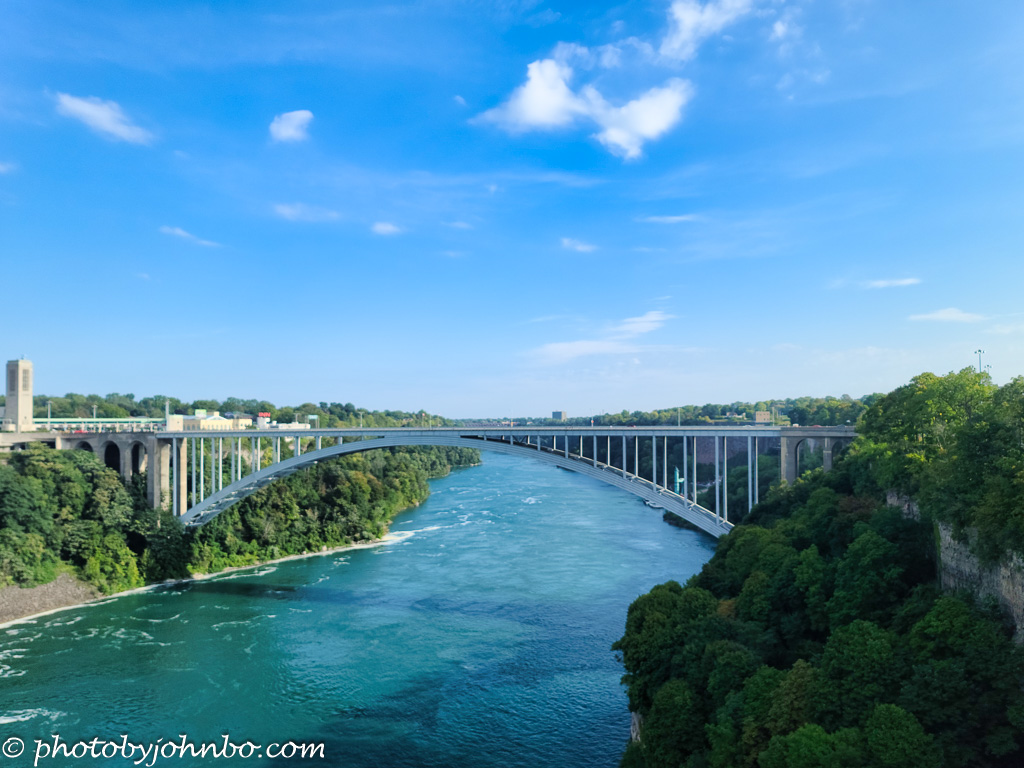
Niagara Falls, New York.
There are so many things to see in Niagara Falls. The area qualifies as a first-class tourist mecca. Regular readers know I like to feature historic bridges whenever possible, and the Rainbow Bridge certainly qualifies. The steel arch bridge connects Niagara Falls, New York, United States, with Niagara Falls, Ontario, Canada. It’s a popular tourist destination offering stunning views of Niagara Falls and the surrounding area.
The bridge is open 24/7; you can walk, bike, or drive across it. Remember that when you cross the bridge, you leave one country and enter another. There are Customs Offices on either side of the bridge, so don’t forget your passport. Also, there’s a toll to cross the bridge, which is collected when you depart the United States.
The bridge is the second bridge across the Niagara River at this site. It was built in 1941 after the previous bridge at the site, the Honeymoon Bridge, collapsed due to an ice jam. When we reached the top of Ontario’s Skylon Observation Tower, I created a large panorama featuring views of the American Falls, the National Park Service Observation Tower, and the Rainbow Bridge. The bright blue sky retreated as the day wore on, and cloudy skies with rain showers began in the afternoon.
The bridge is 950 feet (289.5 m) long, and the deck is 202 feet (61.5 m) above the water. The current flowing under the bridge is strong, averaging 26-30 miles per hour. An estimated six billion pounds of water flows under the bridge every minute. Unlike its predecessor, the bridge is designed to withstand ice jams.
Standing near the edge of the Canadian Horseshoe Falls, I captured a view of the bridge and the American Falls. One of the Maid of the Mist excursion boats is on its way to a close-up view of the Canadian Falls. The bridge’s upper portion features a distinctive framework comprising 76 custom-welded, bent-steel ribs. This design evokes the image of waves crashing along the nearby shoreline. Contrasting the wave-like upper section, the bridge’s base is a sturdy foundation made from approximately 1,200 cubic yards of poured-in-place concrete. This provides a strong and stable support for the bridge.
The designers cleverly concealed all the power and drainage systems for the bridge’s walkway plantings within the concrete spine, maintaining a clean and visually pleasing aesthetic. We didn’t have the chance to see the bridge at night, but I discovered in researching the bridge details that the bridge’s design incorporates a network of 3,500 color-changing LED lights, along with downlights and floodlights. For a better view of the images in this post on a dark background and 2K HD, I’ve put them in an album on my Flickr site here.
John Steiner




I remember paying a toll when I left Canada to walk back to the USA on that bridge.
We were with a tour group, and I wasn’t aware of what the driver did when we stopped at the border areas. I saw the information about the tolls online when I was researching the post. It makes sense to me that the toll would be collected going either way.
It’s possible things have changed since 2016 when pedestrians didn’t pay a toll to exit the USA/enter Canada. They only paid a toll (25 cents per person?) when exiting Canada.
I’ve driven across this bridge but didn’t know the history or stats. Thanks for sharing!
I enjoy learning about bridges and sharing the info when I can.
I’ve walked over that bridge many times.
Cool! I’m sure the views from the walkway are impressive!
Wow that bridge looks really good, it also looks very big.
It is, indeed!